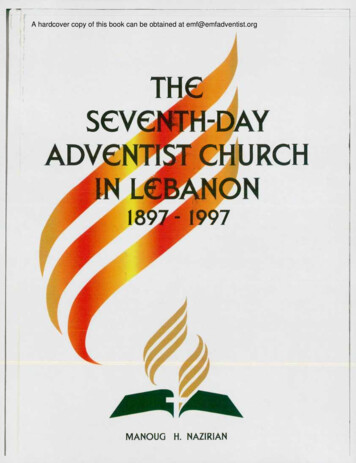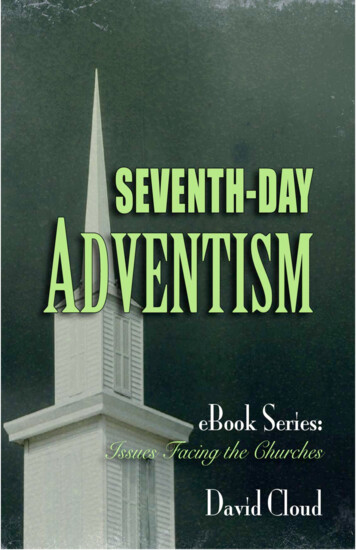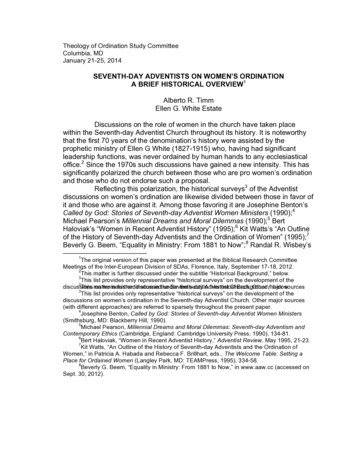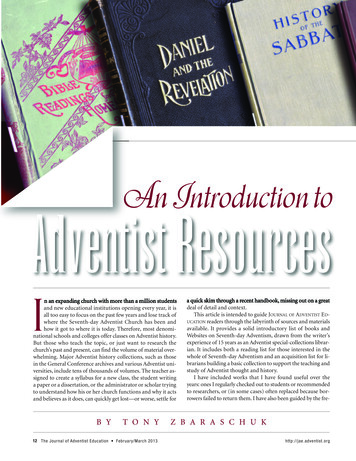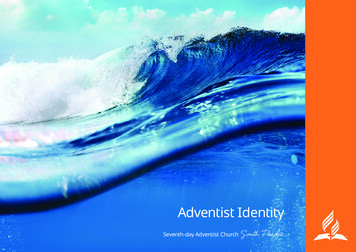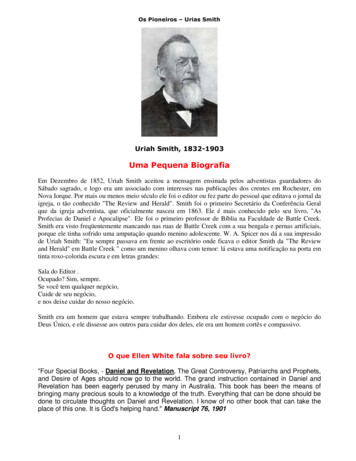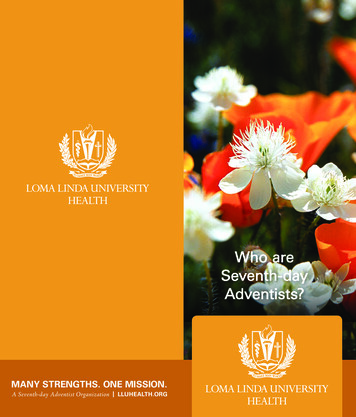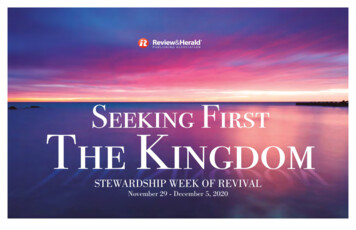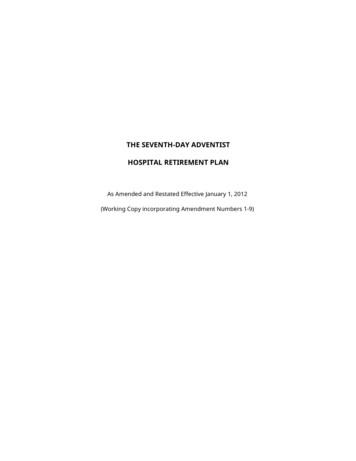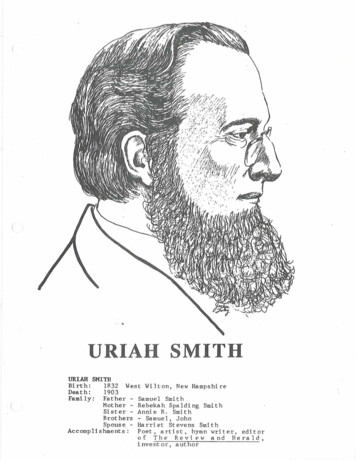
Transcription
.\URIAH SMITHURIAFI SMITHBirth:1832 West W i l t o n , New HampshireDeath:1903Family: Father - Samuel SmithMother - Rebekah Spalding SmithSisterAnnie R . SmithBrothers - Samuel, JohnSpouse, - Harriet Stevens SmithAccomplishments : P o e t , a r t i s t , hymn w r i t e r , e d i t oro f The R e v i e w and H e r a l d ,invent o r , author-
What c h o i c e s would you make a b o u t y o u r l i f e i fyou were 14 y e a r s o l d and y o u r l e g has j u s t b e e namputated?I f you were 19 and a c o l l e g e i n v i t e dy o u t o t e a c h w i t h f r e e room a n d b o a r d p l u s a ne x c e l l e n t s a l a r y ; b e s i d e s t h a t some of y o u r a r twork was j u s t p u b l i s h e d , what would you d o ? U r i a hSmith f a c e d t h o s e problems.U r i a h was A n n i e S m i t h ' s y o u n g e s t b r o t h e r .Both s i b l i n g s s h a r e d i n t e r e s t s i n a r t , w r i t i n g andreading.When he was 1 3 y e a r s o l d U r i a h ' s l e g wasa m p u t a t e d a b o v e t h e k n e e b e c a u s e i t was b a d l yinfected.Can y o u i m a g i n e t h e p a i n h e had t oendure during t h e 20 m i n u t e o p e r a t i o n andbandaging.It i s s a i d t h a t h i s mother h e l d b o t hh i s hands t h r o u g h t h e o r d e a l . When h i s l e g h e a l e dIt washe was f i t t e d w i t h a cumbersome wooden one.s o u n c o m f o r t a b l e that U r i a h ' s c r e a t i v e mind s e t t owork t o f a s h i o n a b e t t e r one t h a t was l i g h t e r i nweight and h a d . movable j o i n t s .He s u c c e e d e d i nc r e a t i n g a workable d e s i g n . He p a t e n t e d t h e d e s i g ni n 18631A l s o , i n 1875 h e p a t e n t e d a f o l d i n gs c h o o l desk s e a t . See t h e d i a g r a m s .-ATLANTIC UNION CONFERENCE-
It i s a n i n t e r e s t i n g f a c t t h a t Uriah Smith'swoodcut i l l u s t r a t i o n s were p r i n t e d i n t h e Reviewa n d H e r a l d when h e was n o t y e t a c o m mc h r i s t i a n . He was 19 y e a r s o l d and was p l a n n i n g t os t u d y a t Harvard.It was some s i x months a f t e r h i swork was p r i n t e d t h a t he began a t t e n d i n g r e l i g i o u smeetings.B e f o r e t h e y e a r , 1852, was t h r o u g h h ehad committed h i s l i f e t o God.During t h e s p r i n gt h e f o l l o w i n e v e a r a l o n e ooem w a s n r i n t r l i n t h eU r i a h j o i n e d h i s s i s t e r Annie i n R o c h e s t e r ,N . Y . and began working i n p u b l i s h i n g .I t was t h eb e g i n n i n g o f 50 y e a r s work f o r t h e R e v i e w a n dHera l d.H i s camouflage h o r s e l e s sc a r r i a g e was q u i t e amazing.E l l e n 6 . White Estate.I n The F o o t r e o r O f T h e Pioneers.Yeshlngton, D . C . :E l l e n White, 1 4 8 5 .Neufeld, Don F r e d .Y a s h i n x t o n , D.C.:1966.Srauffrr. 3.-HSevent h-dav Adventlac Encvclaoedla.R e v e va n o H e r a l d P u b l i r h l n e A s s o e e r o n .Paul." U r i e h Smirh:Wood Fngraver."Summer 1 9 1 6 . p p . l i - 2 1 .ATLANTIC UNION CONFERENCE d e n t i t
URIAH SMITHPerennial Editor of the Review-May 2,1832 March 6,1903Few Seventh-dayAdventists have known their Bibles better than Uriah Smith. He was a quiet,reserved man who impressed people by his learning and appearance. A man of noble countenance, he commanded respect.In December, 1852, he accepted the light of the message taught by the Sabbath-keepingAdventists. The following year he associated with the publishing interests of the "little flock" ofbelievers in Rochester. For about a half century he was the editor or on the editorial staff ofthe church paper, the Review arzd Herald. Uriah Smith was the first Secretary of the GeneralConference, accepting this post at the organization of the General Conference in the springof the year 1863.He is best known for his book, Tlie Proplzecies of Daltiel alzd the Revelation, which has circulated by the thousands of copies. He was the first Bible teacher at Battle Creek College.TJriah Smith was born in a fine-looking house in the little town of West Wilton, Newdampshire. He was as solid in his character as any New Englander, true "grit of the granitestate!' The birthplace of Uriah Smith and his sister Annie still stands in this tiny New Englandtown. It is now called the Eagle House and may be visited by interested tourists.A short time before his death, the main building of the Review and Herald burned down. Thiswas a grave tragedy. The heart and soul of Uriah Smith was bound up with this institution. Hiswhole life had been dedicated to its development.Elder Smith was often seen walking down the streets of Battle Creek with his cane, limpingalong on his artificial limb, for he had suffered an amputation as a teen-age boy. His inventivegenius led him to create an artificial limb which he used during much of his lifetime. He wasversatile and intelligent, as were most of the pioneers. The early workers were people of stature-high caliber. God chose the best that He could find to do the most important work givento men and women in these last days.of the Piorzeers, pp. 123-129; Pioneer Siories Retold, pp. 178-181.See: Footpn ifs
A Story About Urialt SmithWhen Uriah was just twelve years old a local infection brought on by an illness required theamputation of his left leg above the knee. His courageous struggle with pain and shock builtinto his frame of clay those steel girders that made him the solid man he was.Think what it meant to lose a leg in those days. There were no white-robed surgeons and nurses to minister to the patient, no merciful anesthetic, and no competent hospital care. A notedsurgeon of nearby Keene, Dr. Amos Twitchell, cut off the leg and hound it in twenty minutes.Uriah's mother held his hands. Then she and his loving sister took care of him.This injury of his early years brought confinement to Elder Smith in later life. He was not ableto'get out and move around like the other ministers. He just couldn't. So what did he do? Settle down to discouragement? No. His injury was a blessing to him for it brought out his inventive genius. For a while he used the clt msyartificial limb that they provided for him, with asolid foot, but he didn't like it, so he set to work and invented a pliable foot, got a patent forit, and with the money he received from its sale, he bought his first house in Battle Creek.W. A. Spicer gives us his impression of Uriah Smith:"As a boy I always passed Elder Smith's editorial room in the old Battle Creek Review andHerald office with somewhat of awe: for there was a notice on thedoor in dark purple-coloredink and in large letters:"'Editor's Room.Busy? Yes, always.If you have any business,Attend to your business,And let us attend to our business."'--PiatleerDays ofthe Advent Movenletit, pages 245,246.Yes, Smith was a man who was on the march. He was busy with the Lord's business and hewanted others to be about theirs, but he was a graceful and a tender-hearted man. If you don'tthink so, read the last chapter of his book, Tlie Propl eciesofDartie1 arid the Revelation. It willthrill you. It is so full of heart longings for the new earth, our eternal home.
URIAtl SMITH1835 - 1903Just five dollars a week,as the editor-in-chief,so Uriah Smith began.Writer, inventor, preacher, teacher;he was a talented man1For fifty years at the Review,with little help and dollars few.No sacrifice is too great.Send the gospel, at any ratelMessages from God to heed,Always, Jesus Christ must lead.-Lynne E. BuhlerHi young people!I am so glad you are learning about the earlychurch and my friends who were so instrumental in establishing theAdvent message. I have been asked to share with you a little aboutmyself. Well students, for fifty years I was lucky enough to be ofservice for the Lord in the Seventh-day Adventist Church as aneditor and author.But I'm getting ahead of myself.start at the beginning.I need toI began my life in a little town of WestWilton, New Hampshire in 1832.looking house in which I was born.You can still visit the fineIn 1843 I became interested inthe Advent Movement which was spreading like wildfire around myhome town.Two years later at the age of 13, had my left legamputated above the knee, because of an infection. I invented formyself and others who had lost a leg, a more practical and lesspainful artificial limb which I used during much of my lifetime.That artificial limb was just one of my many inventions throughoutby lifetime.In 1857 I married Harriet Newall Stevens. She was as lovely as my
older sister Annie, who was quite a song writer. After becoming aSabbath keeping Adventist I went to work at the Review and Heraldoffice with Annie. I so enjoyed those years working in Rochester,New York, with my sister. I remember my first contribution to theSeventh-day Adventist literature work.It was a 35,000 word poementitled "The Warning Voice of Time and Prophecy". How many of youstudents would like to write a poem that long? It was so long thatit had to be published as a serial in the Review and Herald back in1853.I loved being a worker in the publishing office.In fact,I maintained an almost unbroken connection with the institution ofthe Review and Herald until the time of my death.In 1855 the Review and Herald moved to Battle Creek, Michigan.That same year at the age of twenty-three I became editor.I didnot enter upon that position for ease, comfort, or worldly profit;for I had seen, by my connection with the Review, that none ofthose pleasures were to be found there.In fact I published adisclaimer quite the same in the first issue printed as the neweditor.The primitive equipment in use back then could havedampened a my spirit. In helping prepare the first tracts I woulduse my straight-edge and my pocketknife to trim the edges. I wantyou to know students, "we blistered our hands in the operation, andoften the tracts in form were not half so true and square as thedoctrines we taught."In the early years severe financial problems faced me as the new,young editor.However, I managed the Review through those rough
times to where the paper flourished and grew. In those days I wasthe editor, proofreader, business manager, and bookkeeper. Becauseof all that responsibility I found my physical resources taxed tothe limit.As a result, in 1869 I took some time off torecuperate. My friend J. N. Andrews became editor of the paper inmy absence. Then the next year James White was elected editor andI became associate.again.But 12 months later I became editor onceJames and I didn't always agree on the way to handlecertain problems in the office.One time in 1873 following adisagreement with James over administrative policies I was relievedof my position.After six months I was reinstated to my formeroffice, and James and myfriendship wasre-established andmaintained from then on.I mentioned earlier of my love of inventing.Other then myflexible knee and ankle joints I invented a school desk with animproved folding seat. Because of the patent on my desk I received 3000.Maybe that doesn't sound like a lot of money to you youngpeople today, but with that 3000 I was able to build a new house.In 1876 I was treasurer of the General Conference for a year.In1890 I devoted more time to writing and traveled extensively,speaking frequently at camp meetings.returned as editor of the Review.A year later I againBy the way, students, for atime, I was an instructor of Bible at Battle Creek College.Some people say that I was one of the most fluent writers the
denomination has ever had.I am probably best remembered for mybook generally known by the short title Daniel and the Revelation.Some of the other books I wrote were:Both Sides on the Sabbathand the Law, The Visions of Mrs. E. G. White, and The Sanctuarv andthe 2300 Davs, along with many others.During my life I urged the separation of Church and State,advocated noncornbatancy, and vigorously opposed slavery. I did notapprove of Seventh-day Adventist's seeking political office andcampaigned tirelessly against Sunday laws.I have been told that I was a handsome man of charming manners andmore powerful in pen than in speech.The last words I ever wrote were directed to the General Conferenceon 1903.It summarizes my life long purpose; "1 am with you in theendeavor to send forth in this generation this gospel of thekingdom, for a witness to all nations. And when this is completed,it will be the signal for the coronation of our coming King."Adapted from:The Seventh-dav Adventist Commentarv, Vol. 10
Direction:Help U r i a h Smith and t h e Review make i t s move from Rochestor, New Yorkt o B a t t l e Creek, Plichigan.Help d i r e c t U r i a h on h i s t r e k .
Direction:Help Uriah Smith and t h e Review make t h e move from Rochestor, New Yorkt o B a t t l e Creek, Ilichgan. Help d i r e c t Uriah on h i s t r e k .
Herald office with somewhat of awe: for there was a notice on thedoor in dark purple-colored ink and in large letters: "'Editor's Room. Busy? Yes, always. If you have any business, Attend to your business, And let us attend to our business."' --Piatleer Days ofthe Advent Movenletit, pages 245,246. Yes, Smith was a man who was on the march.
